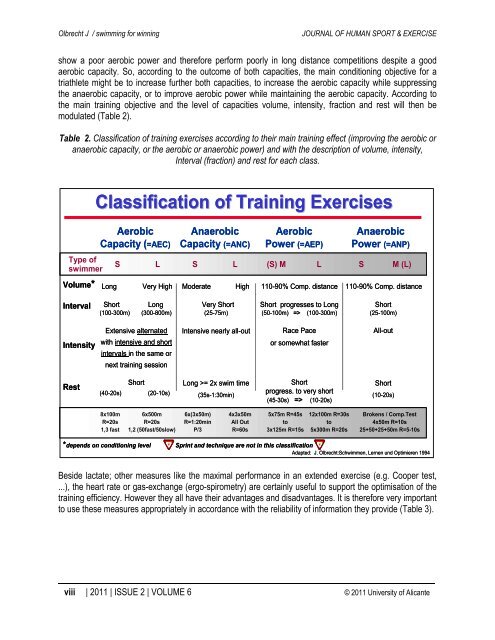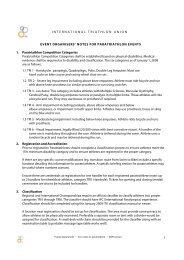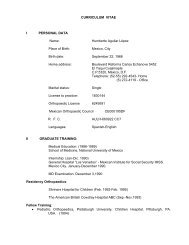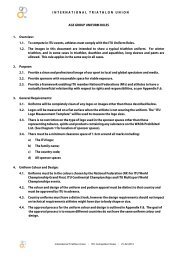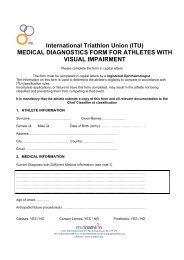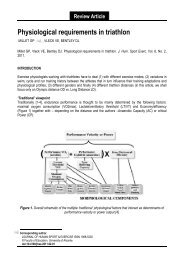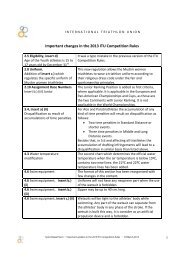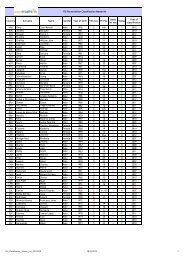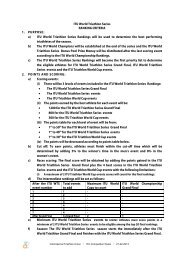Triathlon: swimming for winning
Triathlon: swimming for winning
Triathlon: swimming for winning
Create successful ePaper yourself
Turn your PDF publications into a flip-book with our unique Google optimized e-Paper software.
Olbrecht J / <strong>swimming</strong> <strong>for</strong> <strong>winning</strong><br />
JOURNAL OF HUMAN SPORT & EXERCISE<br />
show a poor aerobic power and there<strong>for</strong>e per<strong>for</strong>m poorly in long distance competitions despite a good<br />
aerobic capacity. So, according to the outcome of both capacities, the main conditioning objective <strong>for</strong> a<br />
triathlete might be to increase further both capacities, to increase the aerobic capacity while suppressing<br />
the anaerobic capacity, or to improve aerobic power while maintaining the aerobic capacity. According to<br />
the main training objective and the level of capacities volume, intensity, fraction and rest will then be<br />
modulated (Table 2).<br />
Table 2. Classification of training exercises according to their main training effect (improving the aerobic or<br />
anaerobic capacity, or the aerobic or anaerobic power) and with the description of volume, intensity,<br />
Interval (fraction) and rest <strong>for</strong> each class.<br />
Classification of Training Exercises<br />
Aerobic Anaerobic Aerobic Anaerobic<br />
Capacity (=AEC) Capacity (=ANC) Power (=AEP) Power (=ANP)<br />
Type of<br />
S L S L (S) M L S M (L)<br />
swimmer<br />
Volume*<br />
Long<br />
Very High<br />
Moderate<br />
High<br />
110-90% Comp. distance<br />
110-90% Comp. distance<br />
Interval<br />
Short<br />
(100-300m)<br />
Long<br />
(300-800m)<br />
Very Short<br />
(25-75m)<br />
Short progresses to Long<br />
(50-100m) => (100-300m)<br />
Short<br />
(25-100m)<br />
Intensity<br />
Extensive alternated<br />
with intensive and short<br />
intervals in the same or<br />
next training session<br />
Intensive nearly all-out<br />
Race Pace<br />
or somewhat faster<br />
All-out<br />
Rest<br />
(40-20s)<br />
Short<br />
(20-10s)<br />
Long >= 2x swim time<br />
(35s-1:30min)<br />
Short<br />
progress. to very short<br />
(45-30s) => (10-20s)<br />
Short<br />
(10-20s)<br />
Example<br />
8x100m<br />
R=20s<br />
1,3 fast<br />
6x500m<br />
R=20s<br />
1,2 (50fast/50slow)<br />
6x(3x50m)<br />
R=1:20min<br />
P/3<br />
4x3x50m<br />
All Out<br />
R=60s<br />
5x75m R=45s<br />
to<br />
3x125m R=15s<br />
12x100m R=30s<br />
to<br />
5x300m R=20s<br />
Brokens / Comp.Test<br />
4x50m R=10s<br />
25+50+25+50m R=5-10s<br />
*depends on conditioning level<br />
Sprint and technique are not in this classification<br />
Adapted: J. Olbrecht:Schwimmen, Lernen und Optimieren 1994<br />
Beside lactate; other measures like the maximal per<strong>for</strong>mance in an extended exercise (e.g. Cooper test,<br />
...), the heart rate or gas-exchange (ergo-spirometry) are certainly useful to support the optimisation of the<br />
training efficiency. However they all have their advantages and disadvantages. It is there<strong>for</strong>e very important<br />
to use these measures appropriately in accordance with the reliability of in<strong>for</strong>mation they provide (Table 3).<br />
viii | 2011 | ISSUE 2 | VOLUME 6 © 2011 University of Alicante


